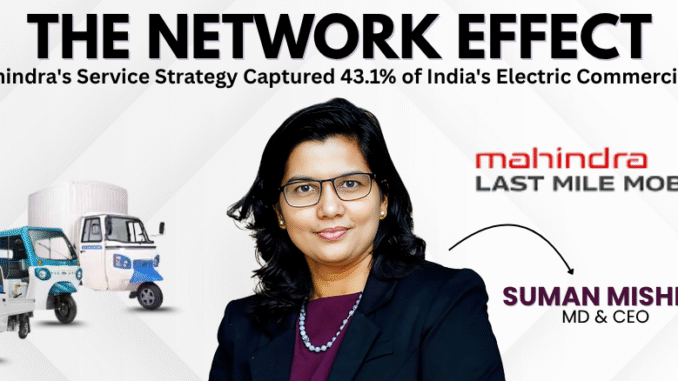
In the hyperkinetic world of electric vehicles, seven years represents multiple technology generations. Mahindra Last Mile Mobility’s 2018 entry into the L5 EV segment wasn’t just early—it was visionary. While competitors spent years debating market readiness and regulatory frameworks, MLMML was methodically constructing the foundation of future dominance: dealer relationships, battery optimization, and service infrastructure. Seven years later, that strategic patience has crystallized into unprecedented market control: 12,500+ commercial EVs sold in September 2025, 43.1% market share, and 51% year-on-year growth. The mathematics of competitive advantage is elegantly simple—every additional year competitors delayed entry gifted MLMML 365 days to deepen customer relationships, refine operations, and construct the infrastructure moat that now appears virtually impenetrable.
The $17.48 Billion Explosion Nobody Predicted
India’s electric commercial vehicle revolution isn’t merely expanding—it’s detonating. The market, currently valued at USD 6.11 billion in 2025, is projected to nearly triple to USD 17.48 billion by 2031, representing an explosive 19.16% CAGR. This transformation anchors India’s broader EV metamorphosis, where the overall market is forecast to surge at an even more aggressive 28.52% CAGR between 2025 and 2030.
The three-wheeler segment has evolved into the unexpected spearhead of this revolution. During FY 2024-25, electric three-wheeler registrations catapulted 11% year-on-year to nearly 700,000 units, with electric models now commanding over 57% of all three-wheeler registrations. What makes this transformation remarkable is its velocity—commercial operators make calculated, emotion-free decisions based purely on Total Cost of Ownership (TCO). When the financial equation favors electric, they transition without sentiment or hesitation.
The Architecture of Dominance: Why 2018 Changed Everything
MLMML’s market supremacy isn’t coincidental—it’s engineered. The company executed their market-defining gamble in 2018, penetrating the L5 EV segment when the category barely registered on industry radar, effectively “paving the way for other legacy OEMs as well as start-ups.” This seven-year temporal advantage enabled them to accumulate brand equity, perfect technology, and cultivate dealer partnerships while competitors remained trapped in strategic planning cycles.
Today, MLMML reigns as India’s No.1 commercial EV manufacturer, commanding a comprehensive vehicle ecosystem including the Treo, Zor Grand, e-Alfa, Treo Yaari, Treo Zor, and Mahindra ZEO 4-wheeler. Their portfolio architecture operates like strategic chess, systematically occupying every market segment and denying competitors uncontested territory—from entry-level urban mobility to high-performance logistics solutions.
The Acceleration Phenomenon: Numbers That Redefine Success
The growth trajectory defies conventional automotive metrics. MLMML delivered 51% growth versus last year’s corresponding quarter in commercial EVs, demonstrating not merely market participation but aggressive market capture. Cumulatively, MLMML has deployed more than 2.85 lakh EVs, with their most recent 1 lakh units delivered in just 13 months—a velocity that signals extraordinary customer validation and market acceptance.
Within the intensely competitive L5M EV category featuring passenger e-autos, MLMML maintains a commanding 43.3% market share despite aggressive competition from both established automotive giants and emerging three-wheeler specialists. This passenger mobility dominance, combined with their 43.1% overall market share across all L5 3W EVs, establishes unquestionable commercial EV leadership.
Beyond Products: The Network Fortress and Emotional Economics
MLMML’s competitive differentiation transcends vehicle specifications. Their extensive dealer and service networks provide customers seamless access to sales and post-purchase support, ensuring the operational uptime that commercial operators consider non-negotiable. For drivers whose income streams depend entirely on vehicle availability, this service infrastructure represents security that competitors struggle to replicate at comparable scale.
The revolutionary breakthrough lies in their UDAY NXT program, featuring benefits including ₹20 lakh accidental insurance coverage and providing advocacy when customers face marginalization. This initiative fundamentally transforms customer relationships from purely transactional exchanges to deeply relational partnerships, creating “emotional switching costs” that competitors cannot overcome through marginal pricing advantages or incremental feature improvements.
The Corporate Fleet Revolution
The most transformative opportunity emerges from B2B fleet electrification initiatives. Corporate behemoths are announcing unprecedented commitments: Amazon targeting 10,000 EVs by 2025, Zomato pursuing 100% electric fleet conversion by 2030, and Uber planning 25,000 EV integrations by 2026. These consolidated procurement pools could reshape industry dynamics overnight, and MLMML’s established market position positions them as the natural partner for such large-scale deployments.
Performance Metrics That Define Leadership
| Metric | Q2 FY25 | Q2 FY26 | Growth Rate |
| Monthly Commercial EV Sales | ~8,300 units | 12,500+ units | 51% YoY |
| L5 3W EV Market Share | ~35% | 43.1% | +8.1 pp |
| Cumulative EVs Sold | ~2.15 lakh | 2.85+ lakh | +32.6% |
The Global Blueprint: Lessons Beyond Indian Borders
MLMML’s success demonstrates how early strategic positioning, comprehensive product architectures, and customer-obsessed approaches generate sustainable competitive advantages in rapidly evolving markets. Their methodology—technologically advanced customer-centric products emphasizing performance, comfort, and profitability—provides a replicable framework for electric commercial vehicle leadership globally.
As India’s electric commercial vehicle market continues its exponential ascent toward USD 17.48 billion by 2031, MLMML’s multi-dimensional strategy positions them to not merely sustain but amplify their dominance. They’ve demonstrated that in revolutionary markets, victory doesn’t necessarily belong to those possessing superior technology—it belongs to those who most profoundly understand their customers’ comprehensive needs and construct unshakeable competitive advantages around that understanding.



